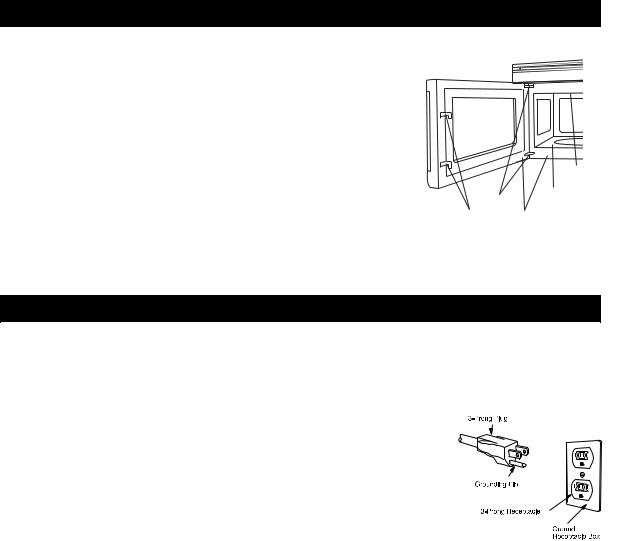Dacor PCOR30S, PCOR30R, PCOR30B User Manual

Use & Care Manual
Over The Range Convection
Microwave Oven
Models PCOR30B, PCOR30R, PCOR30S
IMPORTANT INFORMATION
 Operation Instructions
Operation Instructions
 Cooking Guides
Cooking Guides
 Specifications
Specifications
Please
|
|
|
our Microwave |
|
Before |
Using |
Y |
Read |
|
||
|
|
||
|
|
|
Oven
TINSEB317MRR1

F O R C U S T O M E R A S S I S T A N C E
To aid in reporting this microwave oven in case of loss or theft, please record below the model number and serial number located on the unit. We also suggest you record all the information listed and retain for future reference.
|
MODEL NUMBER ____________________________ |
SERIAL NUMBER _____________________ |
|
|
DATE OF PURCHASE __________________________ |
|
|
|
DEALER _________________________________ |
TELEPHONE ________________________ |
|
|
SERVICER ________________________________ |
TELEPHONE ________________________ |
|
|
|
|
|
TO PHONE: |
1(800)793-0093 |
|
|
TO WRITE: |
DACOR INC. |
|
|
|
|
1440 Bridge Gate Drive |
|
|
|
Diamond Bar, CA 91765 |
|
Please provide the following information when you write or call: model number, serial number, date of purchase, your complete mailing address (including zip code), your daytime telephone number (including area code) and description of the problem.
TO ACCESS INTERNET: www.dacor.com
PRECAUTIONS TO AVOID POSSIBLE EXPOSURE TO EXCESSIVE MICROWAVE ENERGY
(a)Do not attempt to operate this oven with the door open since open-door operation can result in harmful exposure to microwave energy. It is important not to defeat or tamper with the safety interlocks.
(b)Do not place any object between the oven front face and the door or allow soil or cleaner residue to accumulate on sealing surfaces.
(c)Do not operate the oven if it is damaged. It is particularly important that the oven door close properly and that there is no damage to the: (1) door (bent), (2) hinges and latches (broken or loosened), (3) door seals and sealing surfaces.
(d)The oven should not be adjusted or repaired by anyone except properly qualified service personnel.
2

C O N T E N T S
For Customer Assistance .......................... |
2 |
Precautions to Avoid Possible |
|
Exposure to Excessive |
|
Microwave Energy ...................................... |
2 |
Contents ...................................................... |
3 |
Product Limited Warranty ......................... |
4 |
Important Safety Instructions ................... |
5 |
Unpacking Instructions ............................. |
6 |
Grounding Instructions ............................. |
6 |
Information You Need to Know ................. |
7-9 |
About Your Oven ...................................... |
7 |
About Food ............................................... |
7 |
About Microwave Cooking ........................ |
8 |
About Safety ............................................. |
8 |
About Children and the Microwave ........... |
8 |
About Utensils and Coverings ................... |
9 |
Part Names ................................................. |
10 |
Control Panel .............................................. |
11 |
Before Operating ........................................ |
12 |
To Set the Clock ....................................... |
12 |
Stop/Clear ................................................ |
12 |
Manual Microwave Operation ................... |
12-13 |
Turntable On/Off ...................................... |
12 |
Hood Light/Hood Fan ............................... |
13 |
Time Cooking Microwave .......................... |
13 |
Keep Warm ............................................... |
13 |
To Set Power Level .................................. |
13 |
Microwave Features ................................... |
14-19 |
Auto Defrost .............................................. |
14 |
Auto Defrost Chart .................................... |
14 |
Manual Defrost.......................................... |
15 |
Sensor Cooking ........................................ |
15 |
Instant Sensors ......................................... |
16 |
Instant Sensor Reheat .............................. |
16 |
Instant Sensor Popcorn ............................ |
16 |
Popcorn Chart ........................................... |
16 |
Instant Sensor Chart ................................. |
16 |
Sensor Cook ............................................. |
17 |
Sensor Cook Chart ................................... |
17 |
Sensor Cook Recipes ............................... |
18-19 |
Manual Convection /Automatic Mix |
|
Operation .................................................... |
20-24 |
Convection Cooking .................................. |
20 |
To Cook with Convection .......................... |
20 |
To Preheat and Cook with Convection ..... |
20 |
To Broil...................................................... |
20 |
To Slow Cook............................................ |
21 |
Automatic Mix Cooking ............................. |
21 |
To Cook with Automatic Mix ..................... |
21 |
To Preheat and Cook with Automatic Mix |
21 |
Convection Automatic Mix Operation ...... |
22-24 |
Auto Broil .................................................. |
22 |
Auto Broil Chart ........................................ |
22 |
Auto Roast ................................................ |
23 |
Auto Roast Chart ...................................... |
23 |
Auto Bake ................................................. |
24 |
Auto Bake Chart ....................................... |
24 |
Other Convenient Features ....................... |
25-26 |
Multiple Sequence Cooking ...................... |
25 |
More/Less Time Adjustment .................... |
25 |
Kitchen Timer ............................................ |
25 |
Easy Minute .............................................. |
25 |
Demonstration Mode................................. |
25 |
Help .......................................................... |
25 |
Help Guide ................................................ |
26 |
1. Child Lock.......................................... |
26 |
2. Audible Signal Elimination ................. |
26 |
3. Auto Start .......................................... |
26 |
4. Language Selection .......................... |
26 |
5. Weight/Temp Selection .................... |
26 |
Instant On ................................................. |
26 |
Cleaning and Care ...................................... |
27-28 |
Service Call Check ..................................... |
29 |
Specifications ............................................. |
29 |
Quick Reference ......................................... |
30 |
INTERACTIVE COOKING SYSTEM
The Interactive Cooking System offers step-by-step instructions in the display for using the oven, from setting the clock to programming each feature. It also includes Help Guide for instructions on using Child Lock, Audible Signal Elimination, Auto Start and Help. There is a choice of English, Spanish or French and a choice of U.S. Customary Unit-pound or Metric-kilograms. Touch HELP GUIDE and follow the directions displayed or check page 26.
3

P R O D U C T W A R R A N T Y
WHAT IS COVERED
CERTIFICATE OF WARRANTIES
DACOR MICROWAVE OVEN
WITHIN THE FIFTY STATES OF THE U.S.A., THE DISTRICT OF COLUMBIA AND CANADA*:
FULL ONE YEAR WARRANTY
If your DACOR product fails to function within one year of the original date of purchase, due to a defect in material or workmanship, DACOR will remedy the defect without charge to you or subsequent users. The owner must provide proof of purchase upon request and have the appliance accessible for service.
* Warranty is null and void if non-CSA approved product is transported from the U.S.
OUTSIDE THE FIFTY STATES OF THE U.S.A., THE DISTRICT OF COLUMBIA AND CANADA:
LIMITED FIRST YEAR WARRANTY
If your DACOR product fails to function within one year of the original date of purchase, due to a defect in material or workmanship, DACOR will furnish a new part, F.O.B. factory, to replace the defective part. All delivery, installation and labor costs are the responsibility of the purchaser. The owner must provide proof of purchase upon request and have the appliance accessible for service.
WHAT IS NOT COVERED
•Failure of the product caused by faulty installation, improper usage, or neglect of required maintenance.
•Service calls to educate the customer in the proper use and care of the product.
•Failure of the product when used for commercial, business, rental or any application other than for residential consumer use.
•Replacement of house fuses or fuse boxes, or resetting of circuit breakers.
•Damage to the product caused by accident, fire, flood or other acts of God.
•Breakage, discoloration or damage to glass, metal surfaces, plastic components, trim, paint, porcelain or other cosmetic finish, caused by improper usage or care, abuse, or neglect.
THE REMEDIES PROVIDED FOR IN THE ABOVE EXPRESS WARRANTIES ARE THE SOLE AND EXCLUSIVE REMEDIES THEREFORE NO OTHER EXPRESS WARRANTIES ARE MADE, AND OUTSIDE THE FIFTY STATES OF THE UNITED STATES AND THE DISTRICT OF COLUMBIA, ALL IMPLIED WARRANTIES, INCLUDING BUT NOT LIMITED TO , ANY IMPLIED WARRANTY OF MERCHANTABILITY OR FITNESS FOR A PURCHASE. IN NO EVENT SHALL DACOR BE LIABLE FOR INCIDENTAL EXPENSE OR CONSEQUENTIAL DAMAGES NO WARRANTIES, EXPRESS OR IMPLIED, ARE MADE TO ANY BUYER FOR RESALE.
Some states do not allow limitations on how long an implied warranty lasts or do not allow the exclusion or limitation of incidental or consequential damages, so the above limitations or exclusions may not apply to you. This warranty gives you specific legal rights, and you may also have other rights that vary from state to state.
4

I M P O R T A N T S A F E T Y I N S T R U C T I O N S
When using electrical appliances basic safety precautions should be followed, including the following:
WARNING - To reduce the risk of burns, electric shock, fire, injury to persons or exposure to excessive microwave energy:
1.Read all instructions before using the appliance.
2.Read and follow the specific “PRECAUTIONS TO
AVOID POSSIBLE EXPOSURE TO EXCESSIVE MICROWAVE ENERGY” on inside front cover.
3.This appliance must be grounded. Connect only to properly grounded outlet. See “GROUNDING INSTRUCTIONS” on page 6 and INSTALLATION INSTRUCTIONS.
4.Install or locate this appliance only in ac-cordance with the provided installation instructions.
5.Some products such as whole eggs and sealed containers—for example, closed glass jars—are able to explode and should not be heated in this oven.
6.Use this appliance only for its intended use as described in this manual. Do not use corrosive chemicals or vapors in this appliance. This type of oven is specifically designed to heat, cook or dry food. It is not designed for industrial or laboratory use.
7.As with any appliance, close supervision is necessary when used by children.
8.Do not operate this appliance if it has a damaged cord or plug, if it is not working properly or if it has been damaged or dropped.
9.This appliance should be serviced only by qualified service personnel. Contact nearest Dacor Authorized Servicer for examination, repair or adjustment.
10.Do not cover or block any openings on the appliance.
11.Do not store or use this appliance outdoors. Do not use this product near water—for example, near a kitchen sink, in a wet basement or near a swimming pool, or similar locations.
12.Do not immerse cord or plug in water.
13.Keep cord away from heated surfaces.
14.Do not let cord hang over edge of table or counter.
15.See door surface cleaning instructions on page 27.
16.To reduce the risk of fire in the oven cavity:
a.Do not overcook food. Carefully attend to appliance when paper, plastic or other
combustible materials are placed inside the oven to facilitate cooking.
b.Remove wire twist-ties from paper or plastic bags before placing bag in oven.
c.If materials inside the oven ignite, keep oven door closed, turn oven off and disconnect the power cord or shut off power at the fuse or circuit breaker panel.
d.Do not use the cavity for storage purposes. Do not leave paper products, cooking utensils or food in the cavity when not in use.
17.Liquids, such as water, coffee or tea are able to be overheated beyond the boiling point without appearing to be boiling. Visible bubbling or boiling when the container is removed from the microwave oven is not always present. THIS
COULD RESULT IN VERY HOT LIQUIDS SUDDENLY BOILING OVER WHEN A SPOON OR OTHER UTENSIL IS INSERTED INTO THE LIQUID.
To reduce the risk of injury to persons:
a.Do not overheat the liquid.
b.Stir the liquid both before and halfway through heating it.
c.Do not use straight-sided containers with narrow necks. Use a wide-mouthed container.
d.After heating, allow the container to stand in the microwave oven at least for 20 seconds before removing the container.
e.Use extreme care when inserting a spoon or other utensil into the container.
18.Clean ventilation openings and grease filters frequently—Grease should not be allowed to accumulate on ventilation openings, hood (louver) or grease filters.
19.Use care when cleaning the louver and the grease filters. Corrosive cleaning agents, such as lye-based oven cleaners, may damage the louver and the grease filters.
20.When flaming food under the hood, turn the fan on.
21.This appliance is suitable for use above both gas and electric cooking equipment 36” wide or less.
SAVE THESE INSTRUCTIONS
5

U N P A C K I N G I N S T R U C T I O N S
Unpacking and Examining Your Oven
Carefully remove oven from carton. SAVE THE CARTON AS IT MAY MAKE INSTALLATION EASIER.
Remove:
1.all packing materials from inside the oven cavity; however, DO NOT REMOVE THE WAVEGUIDE COVER, which is located on the ceiling in the oven cavity. Check to see that there are Installation Instructions, Wall Template and Top Template. Read enclosures and SAVE the Operation Manual.
2.the feature sticker from the outside of the door, if there is one.
Check the oven for any damage, such as misaligned or bent door, damaged door seals and sealing surfaces, broken or loose door hinges and latches and dents inside the cavity or on the door. If there is any damage, do not operate the oven and contact your dealer or DACOR AUTHORIZED SERVICER.
See Installation Instructions for more details.
Waveguide cover
Oven Hinges cavity
Latches Door seals and sealing surfaces
G R O U N D I N G I N S T R U C T I O N S
This appliance must be grounded. This oven is equipped with a cord having a grounding wire with a grounding plug. It must be plugged into a wall receptacle that is properly installed and grounded in accordance with the National Electrical Code and local codes and ordinances. In the event of an electrical short circuit, grounding reduces risk of electric shock by providing an escape wire for the electric current.
WARNING – Improper use of the grounding plug can result in a risk of electric shock.
Electrical Requirements
Check Installation Instructions for proper location for the power supply.
The electrical requirements are a 120 volt 60 Hz, AC only, 15 amp. or more protected electrical supply. It is recommended that a separate circuit serving only the oven be provided.
The oven is equipped with a 3-prong grounding plug. It must be plugged into a wall receptacle that is properly installed and grounded. DO NOT UNDER ANY CIRCUMSTANCES CUT OR REMOVE THE GROUNDING PIN FROM THE PLUG.
Notes: 1. If you have any questions about the grounding or electrical instructions, consult a qualified electrician or service person.
2.Neither Dacor nor the dealer can accept any liability for damage to the oven or personal injury resulting from failure to observe the correct electrical connection procedures.
Radio or TV Interference
Should there be any interference caused by the microwave oven to your radio or TV, check that the microwave oven is on a different electrical circuit, relocate the radio or TV as far away from the oven as feasible or check position and signal of receiving antenna.
6

I N F O R M A T I O N Y O U N E E D T O K N O W
ABOUT YOUR OVEN
This Operation Manual is valuable: read it carefully and always save it for reference.
A good microwave cookbook is a valuable asset. Check it for microwave cooking principles, techniques, hints and recipes.
NEVER use the oven without the turntable and support nor turn the turntable over so that a large dish could be placed in the oven. The turntable will turn both clockwise and counterclockwise. See page 12 for complete instructions.
ALWAYS have food in the oven when it is on to absorb the microwave energy.
When using the oven at power levels below 100%, you may hear the magnetron cycling on and off.
The fan will automatically start when heat rises from range surface units or burners and when convection, high mix, low mix or the broil settings are used.
Condensation is a normal part of microwave cooking. Room humidity and the moisture in food will influence the amount of moisture that condenses in the oven. Generally, covered foods will not cause as much condensation as uncovered ones. Ventilation openings must not be blocked.
The oven is for food preparation only. It should not be used to dry clothes or newspapers.
Your oven is rated 850 watts by using the IEC Test Procedure. In using recipes or package directions, check food a minute or two before the minimum time and add time accordingly.
ABOUT FOOD
FOOD |
DO |
DON’T |
|
|
|
|
|
Eggs, sausages, |
• Puncture egg yolks before cooking |
• Cook eggs in shells. |
|
fruits & |
to prevent “explosion”. |
• Reheat whole eggs. |
|
vegetables |
|
||
• Pierce skins of potatoes, apples, |
• Dry nuts or seeds in shells. |
||
|
|||
|
squash, hot dogs and sausages so |
||
|
|
||
|
that steam escapes. |
|
|
Popcorn |
• Use specially bagged popcorn for the |
• Pop popcorn in regular brown bags |
|
|
microwave oven. |
or glass bowls. |
|
|
• Listen while popping corn for the |
• Exceed maximum time on popcorn |
|
|
popping to slow to 1 or 2 seconds or |
package. |
|
|
use special POPCORN pad. |
|
|
Baby food |
• Transfer baby food to small dish and |
• Heat disposable bottles. |
|
|
heat carefully, stirring often. Check |
• Heat bottles with nipples on. |
|
|
temperature before serving. |
||
|
• Heat baby food in original jars. |
||
|
• Put nipples on bottles after heating |
||
|
|
||
|
and shake thoroughly. “Wrist” test |
|
|
|
before feeding. |
|
|
General |
• Cut baked goods with filling after |
• Heat or cook in closed glass jars or |
|
|
heating to release steam and avoid |
air tight containers. |
|
|
burns. |
• Can in the microwave as harmful |
|
|
|
||
|
• Stir liquids briskly before and after |
bacteria may not be destroyed. |
|
|
heating to avoid “eruption”. |
• Deep fat fry. |
|
|
|
||
|
• Use deep bowl, when cooking liquids |
• Dry wood, gourds, herbs or wet papers. |
|
|
or cereals, to prevent boilovers. |
||
|
|
||
|
|
|
7

I N F O R M A T I O N Y O U N E E D T O K N O W
ABOUT MICROWAVE COOKING
•Arrange food carefully. Place thickest areas towards outside of dish.
•Watch cooking time. Cook for the shortest amount of time indicated and add more as needed. Food severely overcooked can smoke or ignite.
•Cover foods while cooking. Check recipe or cookbook for suggestions: paper towels, wax paper, microwave plastic wrap or a lid. Covers prevent spattering and help foods to cook evenly.
•Shield with small flat pieces of aluminum foil any thin areas of meat or poultry to prevent overcooking before dense, thick areas are cooked thoroughly.
•Stir foods from outside to center of dish once or twice during cooking, if possible.
•Turn foods over once during microwaving to speed cooking of such foods as chicken and hamburgers. Large items like roasts must be turned over at least once.
•Rearrange foods such as meatballs halfway through cooking both from top to bottom and from the center of the dish to the outside.
•Add standing time. Remove food from oven and stir, if possible. Cover for standing time which allows the food to finish cooking without overcooking.
•Check for doneness. Look for signs indicating that cooking temperatures have been reached.
Doneness signs include:
-Food steams throughout, not just at edge.
-Center bottom of dish is very hot to the touch.
-Poultry thigh joints move easily.
-Meat and poultry show no pinkness.
-Fish is opaque and flakes easily with a fork.
ABOUT SAFETY
•Check foods to see that they are cooked to the United States Department of Agriculture's recommended temperatures.
T E M P |
F O O D |
160˚F ... for fresh pork, ground meat, boneless white poultry, fish, seafood, egg dishes and frozen prepared food.
165˚F ... for leftover, ready-to-reheat refrigerated, and deli and carryout “fresh” food.
170˚F ... white meat of poultry.
180˚F ... dark meat of poultry.
To test for doneness, insert a meat thermometer in a thick or dense area away from fat or bone. NEVER leave the thermometer in the food during cooking, unless it is approved for microwave oven use.
•ALWAYS use potholders to prevent burns when handling utensils that are in contact with hot food. Enough heat from the food can transfer through utensils to cause skin burns.
•Avoid steam burns by directing steam away from the face and hands. Slowly lift the farthest edge of a dish's covering and carefully open popcorn and oven cooking bags away from the face.
•Stay near the oven while it's in use and check cooking progress frequently so that there is no chance of overcooking food.
•NEVER use the cavity for storing cookbooks or other items.
•Select, store and handle food carefully to preserve its high quality and minimize the spread of foodborne bacteria.
•Keep waveguide cover clean. Food residue can cause arcing and/or fires.
•Use care when removing items from the oven so that the utensil, your clothes or accessories do not touch the safety door latches.
ABOUT CHILDREN AND THE MICROWAVE
Children below the age of 7 should use the microwave oven with a supervising person very near to them. Between the ages of 7 and 12, the supervising person should be in the same room.
The child must be able to reach the oven comfortably; if not, he/she should stand on a sturdy stool.
At no time should anyone be allowed to lean or swing on the oven door.
Children should be taught all safety precautions: use potholders, remove coverings carefully, pay special attention to packages that crisp food because they may be extra hot.
Don’t assume that because a child has mastered one cooking skill he/she can cook everything.
Children need to learn that the microwave oven is not a toy. See page 26 for Child Lock feature.
8

I N F O R M A T I O N Y O U N E E D T O K N O W
ABOUT UTENSILS AND COVERINGS
It is not necessary to buy all new cookware. Many pieces already in your kitchen can be used successfully in your new microwave convection oven. The chart below will help you decide what utensils and coverings should be used in each mode.
UTENSILS AND |
MICROWAVE ONLY |
CONVECTION BROIL, |
HIGH MIX/ROAST |
|
COVERINGS |
SLOW COOK |
LOW MIX/BAKE |
||
|
||||
Aluminum Foil |
Yes Small flat pieces of aluminum foil placed |
Yes For shielding. |
Yes For shielding. |
|
|
smoothly on food can be used to shield areas from |
|
|
|
|
cooking or defrosting too quickly. Keep foil at least |
|
|
|
|
1 inch from wall of oven. |
|
|
|
Aluminum |
Yes Can be used if 3/4 filled with food. Keep 1 inch |
Yes Broil - No cover. |
Yes Can be used if 3/4 |
|
containers |
away from walls and do not cover with lid. |
|
filled with food. Keep 1 |
|
|
|
|
inch away from walls and |
|
|
|
|
do not cover with foil. |
|
Browning dish |
Yes Do not exceed recommended preheating time. |
No |
No |
|
|
Follow manufacturer's directions. |
|
|
|
Glass ceramic |
Yes Excellent. |
Yes Excellent. |
Yes Excellent. |
|
(Pyroceram® ) |
|
|
|
|
Glass, heat-resistant |
Yes Excellent |
Yes Excellent |
Yes Excellent |
|
Glass, non-heat-resistant |
No |
No |
No |
|
Lids, glass |
Yes |
Yes Broil - No cover. |
Yes |
|
Lids, metal |
No |
Yes Broil - No cover. |
No |
|
Metal cookware |
No |
Yes |
Yes Do not use metal |
|
|
|
|
coverings. |
|
Metal, misc: dishes with |
No |
No |
No |
|
metalic trim, etc. Metal |
|
|
|
|
twist-ties. |
|
|
|
|
Oven cooking bags |
Yes Good for large meats or foods that need |
Yes Broil - No |
Yes Do not use metal |
|
|
tenderizing. DO NOT use metal twist ties. |
|
coverings. |
|
Paper plates |
Yes For reheating. |
No |
No |
|
Paper towels |
Yes To cover for reheating and cooking. Do not |
No |
No |
|
|
use recycled paper towels which may contain |
|
|
|
|
metal filings. |
|
|
|
Paper, ovenable |
Yes |
Yes For temperatures |
Yes For temperatures up |
|
|
|
up to 400˚F. Do not use |
to 400˚F. |
|
|
|
for broiling. |
|
|
Microwave-safe plastic |
Yes Use for reheating and defrosting. Follow |
No |
No |
|
containers |
manufacturer's directions. |
|
|
|
Plastic, Thermoset® |
Yes |
Yes Are heat resistant |
Yes |
|
|
|
up to 425˚F. Do not use |
|
|
|
|
for broiling. |
|
|
Plastic wrap |
Yes Use brands specially marked for microwave |
No |
No |
|
|
use. DO NOT allow plastic wrap to touch food. Vent |
|
|
|
|
so steam can escape. |
|
|
|
Pottery, stoneware, |
Yes Check manufacturer's recommendation for |
Yes |
Yes Must be microwave- |
|
porcelain |
being microwave-safe. |
|
safe and ovenable. |
|
Styrofoam |
Yes For reheating |
No |
No |
|
Wax paper |
Yes Good covering for cooking and reheating. |
No |
No |
|
Wicker, wood, straw |
Yes May be used for short periods of time. Do |
No |
No |
|
|
not use with high fat or high sugar content foods. |
|
|
|
|
Could char. |
|
|
|
|
|
|
|
DISH CHECK. If you wish to check if a dish is safe for microwaving, place the empty dish in the oven and microwave on HIGH for 30 seconds. If the dish becomes very hot, DO NOT use it for microwaving.
ACCESSORIES There are many microwave accessories available for purchase. Evaluate carefully before you purchase so that they meet your needs. A microwave-safe thermometer will assist you in determining correct doneness and assure you that foods have been cooked to safe temperatures. Dacor is not responsible for any damage to the oven when accessories are used.
9
